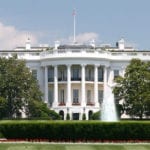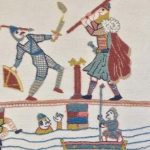 Music
Music  Music
Music  History
History 10 Less Than Jolly Events That Occurred on December 25
 Weird Stuff
Weird Stuff 10 Funny Ways That Researchers Overthink Christmas
 Politics
Politics 10 Political Scandals That Sent Crowds Into the Streets
 Weird Stuff
Weird Stuff Ten Bizarre Facts About The Doge Meme
 Our World
Our World 10 Ways Your Christmas Tree Is More Lit Than You Think
 Movies and TV
Movies and TV The 10 Coolest Stars to Set Sail on The Love Boat
 History
History 10 Things You Didn’t Know About the American National Anthem
 Technology
Technology Top 10 Everyday Tech Buzzwords That Hide a Darker Past
 Humans
Humans 10 Everyday Human Behaviors That Are Actually Survival Instincts
 Music
Music 10 Surprising Origin Stories of Your Favorite Holiday Songs
 History
History 10 Less Than Jolly Events That Occurred on December 25
 Weird Stuff
Weird Stuff 10 Funny Ways That Researchers Overthink Christmas
Who's Behind Listverse?

Jamie Frater
Head Editor
Jamie founded Listverse due to an insatiable desire to share fascinating, obscure, and bizarre facts. He has been a guest speaker on numerous national radio and television stations and is a five time published author.
More About Us Politics
Politics 10 Political Scandals That Sent Crowds Into the Streets
 Weird Stuff
Weird Stuff Ten Bizarre Facts About The Doge Meme
 Our World
Our World 10 Ways Your Christmas Tree Is More Lit Than You Think
 Movies and TV
Movies and TV The 10 Coolest Stars to Set Sail on The Love Boat
 History
History 10 Things You Didn’t Know About the American National Anthem
 Technology
Technology Top 10 Everyday Tech Buzzwords That Hide a Darker Past
 Humans
Humans 10 Everyday Human Behaviors That Are Actually Survival Instincts
Ten Forgotten Facts about U.S. Presidents
Many facts about American presidents seem well-known around the country. High school government and social studies classes and basic civics have (hopefully) done enough for countless generations now to drive home the knowledge of the United States’ past leaders. Who the presidents were, what they accomplished, and what their legacies are today all remain important topics for every American to understand when it comes to appreciating their homeland.
But not every president is equally well-known. On the contrary, many Americans tend to know a lot about a few presidents (think George Washington, Thomas Jefferson, Abraham Lincoln, Franklin D. Roosevelt, and a handful more) and quite a bit less about others. Ask yourself this question: What do you really know about William McKinley? Calvin Coolidge? Grover Cleveland? James K. Polk?
So, with this list, let’s try to expand your knowledge base a little bit. We’ll take a long look at ten forgotten facts about former U.S. presidents. If you know all ten of these facts as you read through them, congratulations! You’re an expert on American history! But our best guess is that you’ll be as surprised as we were to learn some of these lesser-known tidbits about the United States’ former leaders.
Related: Top 10 Presidential “Bad Boys”
10 Grover Cleveland Took a Break
Grover Cleveland was the country’s 22nd president, serving in the White House from 1885 through 1889. He won that term after defeating challenger James G. Blaine in 1884. For a time, Cleveland probably thought he was sitting pretty to be a successful incumbent cruising toward a second term. But it wasn’t meant to be! Not right away, at least.
In 1888, Cleveland lost the follow-up election to Benjamin Harrison. Interestingly, Cleveland won the popular vote that year in raw numbers of ballots cast. But the electoral college didn’t fall his way, and he bowed out from the race, looking like he’d be destined to forever be a one-term president.
But resiliency was a big thing in the Cleveland family, apparently. He was put up for the nomination once more in 1892 to challenge Harrison again. This time, not only did Cleveland win the popular vote, but he broke through the threshold of needed electoral college votes, too. In turn, Cleveland once again became president—this time, the nation’s 24th leader.
He served out a second term from 1893-1897. All that is to say that Grover Cleveland’s political career is one no other American president has done: He is the only person in history to serve non-consecutive terms as President of the United States. But will this achievement still stand after the 2024 presidential election?[1]
9 Benjamin Harrison Made HERstory
While Benjamin Harrison was busy in office between Grover Cleveland’s two terms, he decided to do something no president had ever done before: He hired a woman! On January 2, 1890, Harrison officially welcomed Alice Sanger as the first-ever female White House staffer in American history.
Sanger’s appointment came at a complicated time for women’s rights in the United States. And Harrison was a mostly do-nothing leader, remembered for simply allowing Congress to spend public funds and not much else. But by appointing Sanger as a staffer and adviser, he seemed open to granting influence to major women’s movements that were growing quickly in the country at the time. Both the American Woman Suffrage Association and the National Woman Suffrage Association were pushing for things like women’s property rights, more educational opportunities for girls, better employment options for women, and more streamlined and fair divorce and child custody laws.
While Harrison wouldn’t go so far as to back women’s suffrage and other advancements wholeheartedly, hiring Sanger was a major step in the fight for equal treatment. Suddenly, women had a capable ally on the inside, theoretically working to help advance female causes at a time when they were demanded strongly.
That no other president had ever done it before further signaled a changing of the guard in Washington. Of course, American women wouldn’t get the right to vote until 1920—three decades after Sanger’s appointment—but with moves like this one, the wheels were very clearly in motion.[2]
8 William McKinley’s Money Memory
William McKinley successfully served all of a first term as president after being elected in 1897. And things were going well enough for him that the American people trusted the man for a second term in office, too. He was re-elected as the incumbent and put up for a second term to continue his policies at the very turn of the 20th century. There was just one tragic problem ahead: Merely six months into his second term, McKinley was assassinated.
The president was shot by an anarchist named Leon Czolgosz on September 6, 1901. He died eight days later, with doctors unable to get his health back on track. Then, McKinley was succeeded in office for the rest of that term by his vice president, Theodore Roosevelt. Of course, Teddy turned out to be a very impactful president in his own right. But history didn’t forget McKinley. Well, not for a while, at least.
Years after McKinley’s death, the federal government chose to put the late president’s likeness onto the $500 bill. These “green seal notes,” as they are known, were issued by the Federal Reserve with William McKinley’s face adorning the bill. Unfortunately for him, though, these $500 currency notes were discontinued in 1969.
Citing a lack of need for the bills, the government stopped issuing McKinley-faced notes, and soon, they fell out of regular circulation. That doesn’t mean recent-day economists haven’t argued to bring them back, though. As the financial world continues to develop, it’s possible that McKinley’s face will once again make a return to the economy.[3]
7 Taft’s Big Toss
American leaders throwing out the first pitch at a baseball game is by now a tradition more than a century old. Often done on Opening Day in Washington or other Major League Baseball towns around the country, the commander-in-chief comes down onto the field and tosses a ceremonial throw to kick off the season. Of course, it’s not just on Opening Day that this occurs. Most famously, President George W. Bush tossed a perfect strike—with some velocity behind it, to boot—at the 2001 World Series between the New York Yankees and Arizona Diamondbacks just weeks after the 9/11 terror attacks.
But if you’ve ever seen a presidential first pitch or two and wondered where it came from, well, you can thank William Howard Taft for that. Taft served in the White House from 1909 through 1913, and he was a big baseball fan. The game was really picking up steam nationwide at the time. Of course, it had been invented long before that, in the middle of the 19th century. And as it grew, it eventually carved out a professional circuit and then another. By the early 20th century, it was a massive media and marketing success.
Taft and his advisers recognized the potential there, and on April 14, 1910, they sprung into action. That day, the Washington Senators hosted the Philadelphia Athletics in D.C. to begin the 1910 season. Famed hurler Walter Johnson was on the mound to start the game for the Senators in front of a packed house. But before he could begin pitching, Taft made his opening toss with the entire stadium on the edges of their seats. Ever since, the tradition has stuck. Thanks, President Taft![4]
6 Silent Cal Quiets the Crowd
How much do you know about Calvin Coolidge’s time in office? Chances are you don’t know much about the United States’ 30th commander-in-chief. Part of that isn’t necessarily his fault. After all, he was never quite supposed to be in charge. He had merely been picked as Warren Harding’s running mate ahead of the 1920 election. Then, when Harding won and took office in 1921, it appeared as though the extremely quiet Coolidge would simply play second fiddle as vice president.
But two years later, Harding got severely sick and abruptly died in San Francisco. Only halfway through his term, Harding’s departure into the afterlife necessitated the changing of the so-called guard. Suddenly, Coolidge was thrust into the titular role and granted full access to the White House to enact his own policies. Over the next six years (Coolidge won a term on his own accord in the fall of 1924, which began in 1925), the unlikely president presided very, um, quietly over the country.
Just how quiet was he, though? Well, there’s a legendary (and hilarious) story that has made the rounds for the past century, which claims Coolidge once met a female visitor to the White House. She told him that she knew he had a reputation for being extremely quiet and saying very little. She was going to bring more words out of him, though, and she told him so. The woman boldly claimed she could get “at least three words” out of the silent president. Thinking quickly, Coolidge responded with an amazing quip: “You lose.”[5]
5 Something in FDR’s DNA…
Franklin Delano Roosevelt held the presidency for three terms, from 1933 through 1945. He presided over the United States during two periods of incredible turmoil: the worst years of the Great Depression and then the terrible battles of World War II. But perhaps there was something specific in his DNA that allowed him to lead the nation during such perilous times. We don’t mean that as a throwaway phrase, either; we really think there was something in FDR’s DNA! That’s because genealogists have linked him to at least eleven other former presidents. Eleven!
Of course, there’s Theodore Roosevelt, who was America’s 26th President back near the turn of the 20th century. Teddy was FDR’s fifth cousin, so there’s no doubt about a link there. Beyond TR and FDR’s family tree, though, genealogists think there were far more far-off links to past commanders-in-chief.
According to historians, FDR was supposedly linked in one way or another to George Washington, John Adams, James Madison, John Quincy Adams, William Henry Harrison, Zachary Taylor, Ulysses S. Grant, Benjamin Harrison, and William Taft. And as if that’s not enough, FDR is also Martin Van Buren’s third cousin, four times removed. Plus, other genealogists and historians have claimed FDR has loose familial links to both Winston Churchill and Robert E. Lee. Seriously![6]
4 What’s in a Middle Name? Nothing!
After Franklin Delano Roosevelt’s twelve years in office, Harry S. Truman took his turn in the highest perch in the land. But here’s a fun fact about Harry’s middle name: It doesn’t exist. The “S” in Harry S. Truman didn’t actually stand for anything, as he one day revealed to reporters who queried him about it. The “S” had been a family compromise back in the day between honoring the names of his two grandfathers, Anderson Shipp Truman and Solomon Young. Not picking one “S” name over the other, young Harry got the initial alone as a way to carry on their legacies.
Amazingly, Truman isn’t the only past president to have a non-existent middle name. And he’s not even the only one to make that phony middle moniker out of an “S”! As it turns out, Ulysses S. Grant was never actually supposed to be known as Ulysses S. Grant. He was born Hiram Ulysses Grant and then went on to join the army at a young age under an assumed name. Unfortunately, when he was nominated to the military academy at West Point, a congressman who wasn’t paying attention to the forms he was filling out lopped off the first name “Hiram” and gave Grant the unexplained middle initial.
Grant didn’t mind the change, though. At first, he tried to straighten out the mix-up, but nobody at West Point pushed the paperwork through. Then, he just decided to keep the name as-is and live under his new, somewhat-assumed identity. In turn, his critics would come to know him as “Unconditional Surrender” Grant and his backers as “Uncle Sam” Grant, both playing on the “U.S.” initials that were not totally true. Regardless, the new identity finally offered Grant some good fortune when it got him all the way to the White House later in life. By then, he was used to the new name, so he kept it![7]
3 A Texan Teacher Before Politics
Lyndon Baines Johnson became America’s 36th President when he assumed office in 1963 after the assassination of John F. Kennedy. Following the end of what would have been Kennedy’s full term, LBJ took the reins on his own for his shot as first fiddle in the White House from 1965 through 1969. Of course, Johnson’s time in office was marked by major social upheaval domestically and the Vietnam War trudging along endlessly in southeast Asia.
All the while, LBJ tried to offer up a folksy and jovial demeanor with aides, friends, colleagues, and reporters alike. The down-home Texan appealed to enough people in that way to earn his second term and come away reasonably popular after a very difficult term with plenty of social problems and policy concerns all around. Perhaps Johnson could point to his prior career to prepare him for those difficult times, though. After all, there are few jobs more chaotic than being thrown into a classroom with a few dozen young people at once!
Before getting into politics, Lyndon B. Johnson was a teacher for four years. He worked at a hard-scrabble school deep in south Texas, right along the U.S.-Mexico border. Most of his students at the time didn’t speak English, and Johnson couldn’t speak Spanish. Somehow, though, he persevered for those four long terms in the classroom. Years later, he would credit that job for helping him prioritize education policy in the White House.[8]
2 Nixon: The Poker Shark
Richard Nixon is remembered for the infamous and not-so-wholesome end to his presidency in 1974. But the California native actually got into political office in the first place because of some dastardly deeds. As it turns out, during World War II, Nixon was stationed in service way out in the Solomon Islands. While on active duty during the Pacific front there, he became notorious among other servicemembers around the base as a highly-skilled poker player.
Nixon really knew when to go all-in and when to fold, too—the tales of his poker prowess aren’t just legends that have grown over the decades. In reality, Nixon was able to win so much money playing poker during World War II out in the South Pacific Ocean that he took much of it home to California with him. In turn, that not-so-small sum of cash literally helped launch his very first local political campaigns. Now, that’s one way to fundraise! Come to think of it, compared to the endless fundraisers that go on in modern politics, maybe Nixon’s card table tactics weren’t so bad after all![9]
1 Ford’s Football Glory
Gerald Ford may have followed up after Richard Nixon’s resignation as the country’s 38th president. Still, years before he reached the White House, he did his own impressive things. For one, Ford—a Michigan native—was a star football player at the University of Michigan during his college days. He helped the powerful Wolverines win two Big Ten Conference titles and national championships with two undefeated seasons in both 1932 and 1933.
Then, in 1934, even though the team lost all their other stars besides Ford, he stayed on and earned himself notoriety from pro football scouts. He was even offered football contracts by both the Detroit Lions and the Green Bay Packers, though he turned them down.
On-field prowess wasn’t Ford’s only achievement at Michigan, though. Also in 1934, the Wolverines were scheduled to play powerhouse Georgia Tech in a game. In the week before the game, though, the Yellowjackets publicly stated they would not play Michigan because the Wolverines had a Black player named Willis Ward on their team.
When Ford heard this about his friend and teammate, he immediately stood up and told his coaches that if Ward wasn’t going to play, he wasn’t going to play, either. Ford stuck to his guns, too, right up until Ward himself begged the future politician to suit up and play the game.[10]








